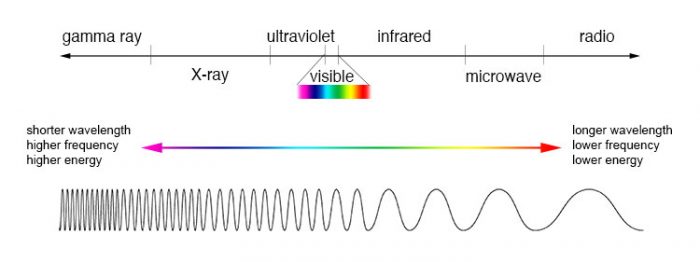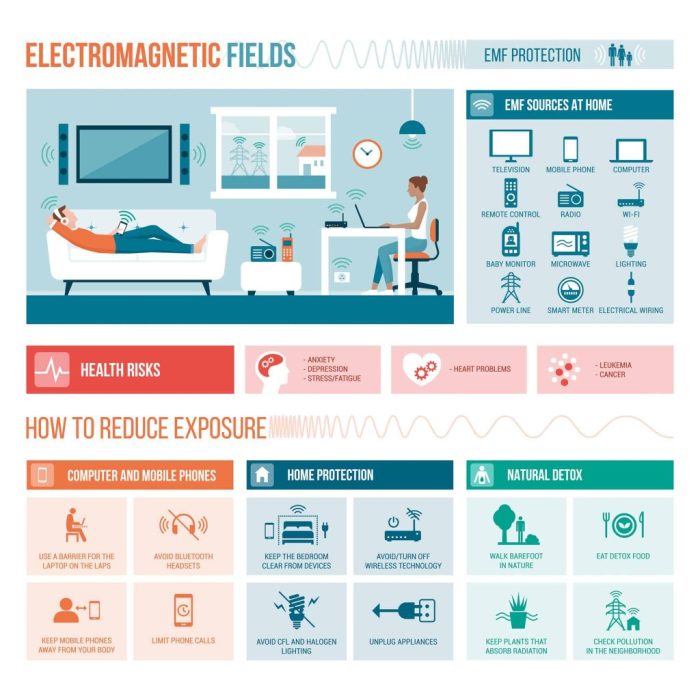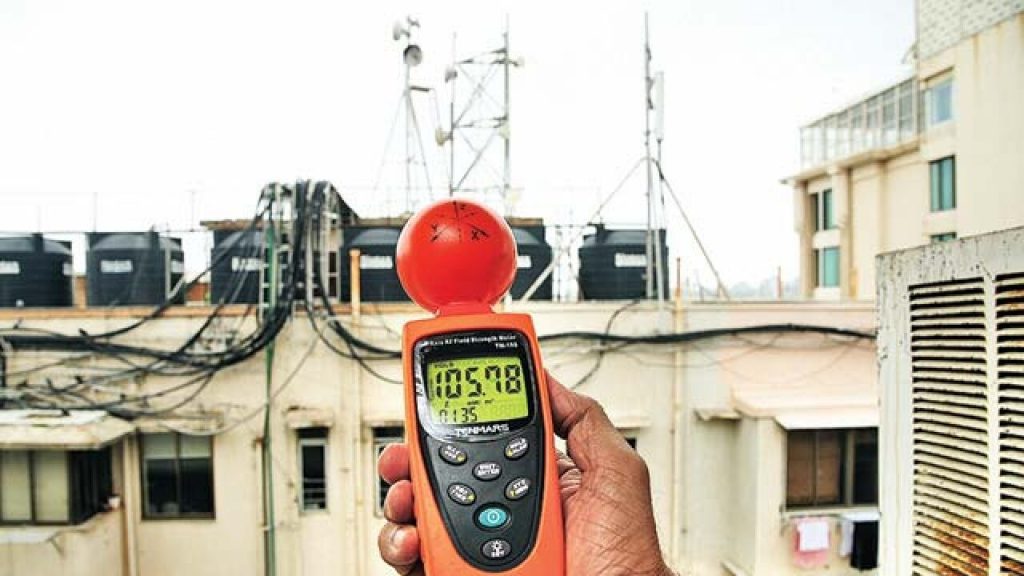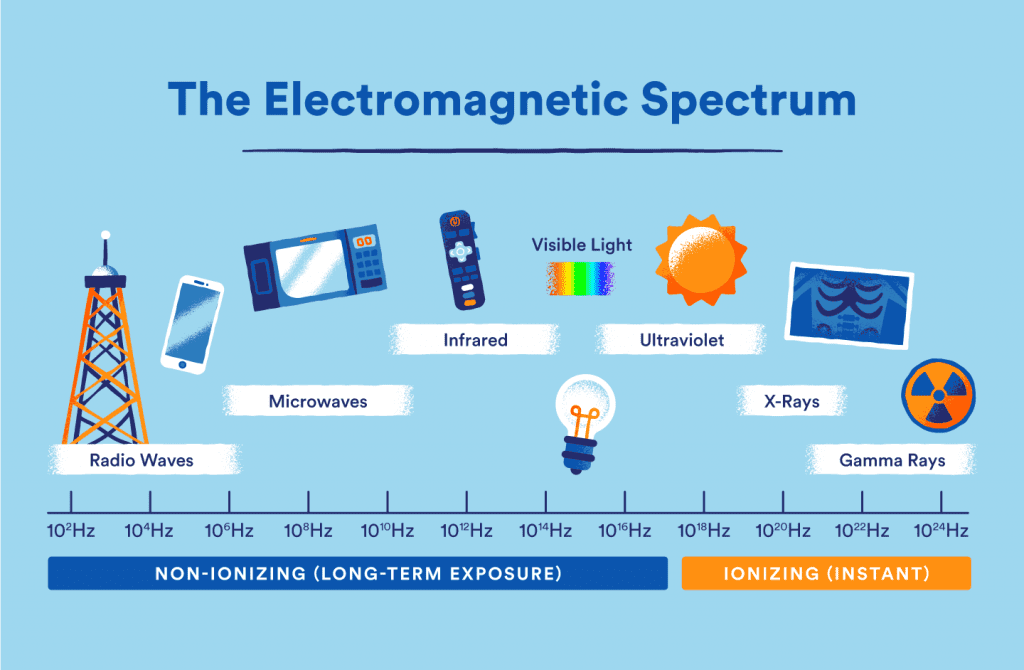With the growing awareness about the harm of the EMF radiation to human health, people are getting themselves EMF meters to ensure that they are not exposed to an unhealthy amount of radiation. However, the EMF units displayed on the meter, and the interpretation of the reading can be difficult, if you are not familiar with the concept of electromagnetism.
We have shared plenty of information, so you can accurately gauge the health risks associated with a high level of EMF radiation. You may see a variety of units in reference to EMF; we hope to clarify them so that you know what each of them stands for.
How to Read EMF Meter
If you are concerned about the level of EMF radiation, you are not overreacting. This is indeed a genuine concern. With technological advancement, comes the risk of health hazards. Now, assuming you have already purchased a meter and detector, we will help you understand how to make sense of the reading and understand the EMF measurement unit.
What is EMF Radiation?
Before we can discuss various units associated with EMF quantities like frequency and strength, let’s first grasp the concept of EMF radiation.
What is it? EMF is basically a field created by electrically charged objects in motion.
Yes, your computer, microwave oven, WiFi router, cellphones, Bluetooth devices, and other similar devices are emitting such radiation. Measuring the strength and frequency of these types of radiation will help you find out whether you are exposed to a safe amount of radiation or not.
Electric Field
The electric field is one of the causes of EMF radiation. Any electrically charged particle has an electric field associated with it, even if it’s static and not in motion. The standard unit for its measurement is Volts per Meter(V/m). The direction of this field is always perpendicular to that of the magnetic field in an electromagnetic wave.
Magnetic Field
Unlike an electric field, only moving charges can produce a magnetic field. The SI unit used for the measurement of magnetic fields is Tesla(T).
Both of these fields were initially thought to be separate forces with no correlation whatsoever. However, in 1873 a Scottish scientist Maxwell proved otherwise. He studied how these were interlinked and how charged particles interact with magnetic fields.
Decoding the Electromagnetic Spectrum
An electromagnetic field isn’t uniform. There are regions that are more energetic(high frequency) while others that are less energetic(low frequency). The Electromagnetic Spectrum is a term used to describe the complete range of light that exists.
But when we say light, we don’t just mean the visible light with seven colors(or wavelengths) but we mean the entire range of electromagnetic waves, radio waves being the lowest in frequency and gamma rays being the highest in frequency. The light that is visible to us falls somewhere in between this spectrum.

Understanding Radiation Frequency
Now that we have covered the fundamentals of EMF, let’s look into quantities that are measurable, and can help us calculate the extent of our exposure to these radiation types in our homes or offices.
Frequency is the measure of the number of complete cycles in a single unit of time. For electromagnetic radiation, it’s the measure of the number of wave cycles per second. Knowing the frequency of radiation that you are exposed to can help you assess the risks it may cause to your health.
The AM Radio or FM Radio usually emits radiation in the range of a few hundred kilohertz(kHz) frequency. Whereas Bluetooth, WLAN, or high-speed data links generally operate within the gigahertz range.
Strength of Radiation
In any practical scenario, the measure of the strength of radiation is ideal to know if you may be susceptible to health issues due to prolonged exposure to it. The EMF units commonly used to denote this value are Volts, Watts, and Gauss. The reason why we have to use varying EMF units for measuring the strength is that it differs based on the type of radiation as well as the location.
Radiofrequency Radiation
Radio frequencies are a part of the EM spectrum that is quite common in our daily lives. For this reason, it may be a good idea to discuss the measurement units for it.
Both Bluetooth and WiFi signals propagate using radiofrequency. These technologies impact our cells by heating them(thermal radiation effect) and they also affect us on a biological level. Those who are sensitive enough can sometimes feel this radiation as sensations on their skin.
The commonly used unit for measuring RF radiation is V/m. Another less common unit that can be used is microwatts per square meter. The magnitude of radiation you measure plays a significant role in deciding the units. There is no point in using a larger unit like W/m when measuring really small amounts of radiation.
Units for Magnetic Field Radiation
Now, this may vary depending on what part of the world you live in. In the US people generally use Gauss to measure the magnetic fields. But most other parts of the world use Tesla to measure these fields. A smaller unit for Gauss is milliGauss while for Tesla it is nanotesla.
1 Milligauss (mG) = 100 Nanotesla (nT)
Remember that these values tell us about the strength of the magnetic field. There are some other units too like OE and Maxwell, but these are not used when using an EMF meter. You just need to remember Tesla or Gauss, based on where you are located. 1 Gauss stands for One Newton per Ampere meter.
Units for Electric Field Radiation
The electric field is one of the components of an EM field. A volts/meter (V/m) unit is used to measure it. This unit is mostly built into the EMF meters and is therefore easy to work with.

How to Measure EMF Radiation
Any efficient EMF meter would let you measure all three types, which are RF, Magnetic, and Electric Field. Though each device may be a little different, the general procedure remains the same.
Sweep the area with your device
Flip your EMF meter to where it says ‘Magnetic Field’ because there are plenty of objects in a house that emits magnetic field. Now survey and scan each room one at a time with your EMF meter. Keep a notebook handy, so you can note down every reading when you spot radiation.
It may be a good idea to start with a place near your PC. Place your EMF meter in front of you and walk forward while tracing the device to and from, back and forth.
Look out for spikes in the reading
One common question that we get is ‘where to start looking?’. Sometimes the objects responsible for radiation are not so obvious in the room. In that case, start with any place you like and keep an eye on the meter reading. Any sign indicating higher radiation than usual is a good place to scan thoroughly.
Once you have spotted the source of the spike in radiation amounts, consider if the object supports wireless connectivity. If not, just scan around that object and note down the average meter reading. Once you are done, you can move on to the next part of the premise.

Consider the more active areas for you
This part perhaps is the most important part while using an EMF meter to eliminate exposure and lower the health risks you might be facing. It doesn’t matter if a certain part of your house has high levels of radiation if you spend negligible time in that area.
So what makes more sense is to scan more thoroughly the parts of your house or workplace, where you spend maximum time. This is because the adverse effects of radiation do not manifest instantly, radiation-related ailments take time to develop. Constant exposure should therefore be avoided by all means possible.
The starting points for scanning with your EMF meter should include:
- Place where you sleep
- Place of work
- The vehicle you use to commute
- Spots for reading, listening to music, or playing games daily
If you detect unusual readings in any of these places, it may be time to make some changes. Continued exposure is what has made health conditions worse for many people.
RF radiation from wireless devices
There is a vast array of electronic objects that we use, which is a source of radiofrequency radiation types. Few of them are excessively used by most humans and they are; tablets, Bluetooth headphones, smartphones, smart-refrigerator, home security systems, and so on.
But before you move on to scanning such devices, configure your EMF meter to detect Radio Frequencies(RF). To measure RF radiation, place the device you want to scan on the floor, on a table, or just hold it in your hand if it’s tiny enough.
Point the meter at the device but keep a distance of 1 or 2 feet. Now slowly move the EMF meter closer to the object and note down the peak radiation reading. This reading will generally be milliwatts per square meter. You will probably notice a difference in how signals are detected for magnetic or electric radiation and for radiofrequency.
Steady emission vs. pulse emission
Electric or magnetic emissions are in the form of continuous radiation. But information over wireless networks is passed as packets of data, sent over radiofrequency waves. So to detect these varying pulses, you need to wait until you pick at least one packet of data.

Factors to Consider when Measuring EMF Radiation
Seasonal radiations are harmless
As discussed, any harmful effect of radiation is caused by prolonged exposure. Seasonal radiation hikes are temporary spikes in the level of radiation for climatic reasons.
For instance, during hot summer days, most of the air conditioners in your home will be turned on. This may cause higher amounts of radiation to be detected by your EMF meter. These readings will only be temporary and will be picked at specific hours of the day.
Likewise, during winter, the heating systems may lead to similar readings on your EMF meter. But such radiations are not causing any constant exposure to your body, and are therefore harmless. You don’t need to worry too much about seasonal radiation. These readings aren’t a true representation of the total exposure to EMF radiation.
A single device emitting different radiation types
It is possible that some of the devices like a hairdryer or a laptop may be emitting more than one type of radiation. For instance, if your laptop is using WiFi internet, your EMF meter will pick RF, electric, as well as magnetic field radiation. However, to record all the types of radiation readings, you will need to configure your EMF meter for each type of radiation.
You can start with magnetic radiation settings on your EMF meter; carry out a thorough scan of your device, then switch to another mode for RF or electric field.

Which Reading Values are High?
Just getting some random value on your EMF meter doesn’t help you understand if the radiation levels are unsafe for you. We would like to help you understand what some normal readings to expect and when they could be too high and therefore unsafe for you.
Constant exposure to high levels of radiation could lead to various health issues. The researches about the EMF radiation harms are still ongoing, but why wait to fully understand the potential risks? It’s better to not let yourself be exposed to unhealthy radiation levels. Measuring the EMF in your home is an effective solution.
Some of the reported symptoms of exposure to electromagnetic fields are; anxiety, headaches, nausea, fatigue, depression, and loss of libido. Other studies also suggest that EMF radiation can be potentially carcinogenic.
High Magnetic Field readings
The safety guidelines regarding exposure to the magnetic field are mostly based on ICNIRP and IEEE. The maximum limit prescribed by them is usually very high due to their stricter guidelines. According to ICNIRP guidelines for maximum exposure to the magnetic field, they have set the limit at 2000mG.
For most households, the MF readings will be somewhere around 0.1 mG. If you live in an apartment, this reading could be a little higher, but the chances of touching the maximum safety limit are pretty low. So, if you find MF radiation readings close to the highest mark, your body may be susceptible to serious biological harm.
High Electric Field readings
Mostly no one talks about the harms of electric field exposure. However, there is a safety limit recommended by ICNIRP and that is, 5000V/m. So if your EMF meter detects a value higher than this, you need to be worried about it.
However, based on some other studies, if the ambient EF meter reading is higher than 10V/m, it would be considered dangerous for your health. Make sure that the electronics in your home are emitting EM between 1 and 5 V/m.
High Radiofrequency readings
High levels of radio frequencies are the most detrimental to your health. When measuring EMF meter reading for RF, you should pay attention to the peak number and not the primary number.
The regulatory limits for this reading are quite high, but according to study reports, even at a lesser value people may begin to experience headaches, insomnia, or concentration issues.
As per this study, people may begin to notice signs of health problems at radiation levels between 0.003 and 0.05 μW/cm2. This equals 0.03 and 0.5 mW/m2. 1 mW/m2 should be considered as a high reading value.
Electro-Hypersensitivity
We will have a different set of high readings for people with EHS. These are the people who are extremely sensitive to electromagnetic fields. These people can feel lower limits than other people. In fact, these people can detect RF or ELF radiation by their skin. They feel a buzzing sensation on their skin when exposed to high levels of EMF radiation.

Appliances which Emit High Radiation
Induction cooktops
In most homes, it can be the highest EMF emitting source. But there is no RF radiation component emitted from this device. The EMF reader detects about 400 V/m of electric field and 140 mG of a magnetic field at a 3-inch distance.
Cell Towers
These are the primary source of concern for people sensitive to EMF radiation. The sad part is we cannot do anything about them. The reading value we detected from one of the towers was about 2 V/m. Which is quite high compared to the recommended value for homes.
Microwave ovens
These cause the highest amount of EMF radiation in most homes. But it does depend on the size of the microwave oven and also how long you use it. Typically, you only use it for a few minutes, so it shouldn’t be a cause of worry, but in case you use it a lot, make sure the readings aren’t too high.
Smart Meters
These are the worst kinds of polluters for EMF radiation. When these devices calibrate with other meters in your neighbourhood, they typically emit radiation at the level of 6 V/m, which is quite higher than the recommended value of 0.2 V/m. But the reading in your case may vary depending on the brand you are using.
Laptop
Now, if you don’t use your laptop much, then you are completely safe from the radiations it may emit. If you do use it excessively, remember that it uses both Bluetooth and WiFi.
In case, you have to use it your computer or laptop, you can opt for an ethernet cable so you don’t have to be exposed to WiFi for a longer duration. In this way, you can completely get rid of the RF radiation. Also, if this is not feasible for you, make sure to keep 1-2 feet of distance from it. Don’t keep it on your lap!
Wi-Fi routers
These are other sources of radiation that should concern you. If it’s placed somewhere close to the living area or the bedroom at least switch it off for the night. The reading generally varies from 1.3 V/m to 4 V/m for a distance from 1 inch to 1 foot. Ethernet cables are the ideal solution for this if you find high radiation levels.
There is a lengthy list of electronic equipment used at homes that may be increasing the radiation levels. It’s difficult to list all the items that you need to worry about, but if you scan your house with an EMF meter, you can easily spot more items with radiation beyond the recommended limit.
Frequently Asked Questions
Do I really need an EMF meter?
Yes, if you are concerned about the adverse health effects of a high amount of EMF radiation, there is no better way than to get yourself an EMF meter. It’s better to know what levels of radiation you are exposed to and do something about it, then to stay clueless.
It is prolonged exposure to radiation that is harmful and not if you are only temporarily exposed to it. So, the earliest you find out if you are at the risk of EMF induced illnesses, the better it is. Learning how to measure EMFs is really easy once you understand the EMF units.
How to Convert V/m to W/m²?
We don’t intend to get too technical, but if you need to know how to convert the units, here is the formula.
V/m = (W/m2 x 377)1/2
So, if you need to convert 1 mW/m² to V/m, place 0.001 in this equation and you will get 0.6 V/m.
The units for EMF may vary based on the type of radiation you are measuring. For this reason, you should know how to convert the common EMF units.
Conclusion
Taking charge of the levels of radiation you expose yourself to is a good move in the direction of a healthy life. Even if you don’t experience serious health issues, disturbance in sleep patterns or concentration due to prolonged exposure can severely reduce the productivity in your life.
Make sure that you pay attention to the areas where you spend most of your time. If you spend a long time close to a source of radiation, that’s a cause of concern.
